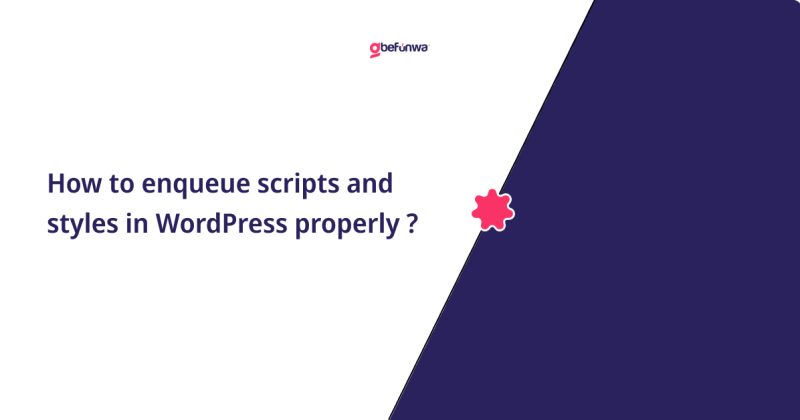
When it comes to WordPress development, quick and seamless user experience is mostly dependent on how well scripts and styles load. In addition to improving website speed, correctly enqueuing scripts and styles is essential for preserving code organization and theme and plugin compatibility. We will go into the best practices for enqueuing styles and scripts in WordPress in this extensive book, covering everything from fundamental ideas to sophisticated methods.
Understanding Enqueuing
Before we dive into the specifics of script and style enqueueing, let’s clarify what enqueueing entails. Enqueueing refers to the process of adding scripts and styles to WordPress themes or plugins in a systematic and controlled manner. By enqueuing scripts and styles, developers can ensure that dependencies are properly managed, conflicts are minimized, and resources are loaded in the correct order.
Basic Enqueueing Principles
When enqueuing scripts and styles in WordPress, it’s essential to adhere to the following basic principles:
1. Use the `wp_enqueue_script()` and `wp_enqueue_style()` Functions
WordPress provides dedicated functions for enqueuing scripts and styles. These functions handle the registration, loading, and dependencies of resources efficiently.
2. Leverage WordPress Hooks Enqueuing scripts and styles should be done within the appropriate WordPress hooks, such as `wp_enqueue_scripts` for frontend assets and `admin_enqueue_scripts` for backend assets.
3. Specify Dependencies and Versioning
Specify any dependencies (such as jQuery) when enqueuing scripts to ensure they are loaded in the correct order. Additionally, include a version number to facilitate caching and prevent conflicts with cached versions.
4. Minimize Render-Blocking Resources
To improve page load times, designate non-essential scripts and styles as asynchronous or deferred to prevent them from blocking the rendering of critical content.
Advanced Enqueuing Techniques
Beyond the basic principles, there are several advanced techniques that developers can employ to optimize script and style enqueueing in WordPress:
1. Conditional Loading: Use conditional tags to selectively enqueue scripts and styles based on specific criteria, such as page templates, post types, or user roles. This ensures that resources are only loaded when necessary, reducing unnecessary overhead.
2. Localized Script Data: When enqueuing JavaScript files that require access to PHP data, use the `wp_localize_script()` function to pass localized data securely from PHP to JavaScript. This technique is particularly useful for passing dynamic data such as AJAX URLs or nonce values.
3. Custom Asset Handling: For complex projects or themes with custom requirements, consider implementing a custom asset handling system using classes or helper functions. This allows for greater flexibility and organization when enqueuing scripts and styles across multiple files or components.
4. Asset Optimization: Implement techniques such as script concatenation, minification, and compression to reduce the size of assets and improve loading times. Additionally, consider utilizing Content Delivery Networks (CDNs) to serve assets from geographically distributed servers for faster delivery.
Best Practices for Theme and Plugin Development
When developing themes or plugins for WordPress, it’s crucial to follow best practices for script and style enqueueing to ensure compatibility and maintainability:
1. Modularization: Organize scripts and styles into modular files or components to improve code organization and reusability. Use conditional loading and dependency management to only load resources when necessary.
2. Compatibility Testing: Test themes and plugins with popular caching plugins, optimization tools, and third-party scripts to identify and resolve any conflicts or performance issues related to script and style loading.
3. Documentation and Support: Provide clear documentation and support for developers using your themes or plugins, including guidelines for enqueuing scripts and styles and troubleshooting common issues related to asset loading.
4. Regular Updates: Stay up-to-date with changes to WordPress core and best practices for script and style enqueueing. Regularly update themes and plugins to incorporate improvements, bug fixes, and optimizations related to asset loading.
Conclusion
A key element of WordPress development is effective script and style enqueueing, which enhances user experience, code structure, and performance. The fundamental ideas and sophisticated methods described in this tutorial can help developers streamline asset loading, minimize conflicts, and produce reliable themes and plugins that match industry standards. Learning the skill of enqueuing scripts and styles will take your WordPress projects to new levels, regardless of your experience level. This applies to both novice developers learning the ropes and seasoned developers streamlining their workflow.
Deborah Oludimu is an experienced content writer with 3+ years of experience. She is skilled in research, writing, and editing to produce high-quality, engaging content across industries. Deborah is passionate about creating content that informs and inspires
© 2025 GBEFUNWA.COM. All rights reserved.
The WordPress® trademarks are the intellectual property of the WordPress Foundation, and the Woo® and WooCommerce® trademarks are the intellectual property of WooCommerce, Inc. Uses of the WordPress®, Woo®, and WooCommerce® names in this website are for identification purposes only and do not imply an endorsement by WordPress Foundation or WooCommerce, Inc. gbefunwa is not endorsed or owned by, or affiliated with, the WordPress Foundation or WooCommerce, Inc.